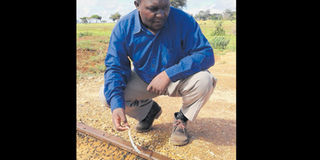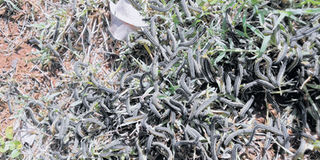Premium
Armyworms are ravaging hundreds of farms; here’s how to defeat them

A man looks at armyworms in his farm in Taita Taveta. Armyworms have the potential of causing famine since the larva not only feeds on staple food crops, but also grass, pasture and any green vegetation mainly the leaf lamina, leaving only the mid-rib. PHOTO | DANIEL NYASSY | NATION MEDIA GROUP
What you need to know:
- The Armyworms arrived in Kenya as eggs in imported maize or were spread by winds.
- Armyworms are migratory pests normally referred to as Notifiable insects, which are categorised in the group of other deleterious pests like locusts and quelea quelea birds.
- The worms are a serious global pest and breed all-year round in most tropical countries.
- High risk armyworm outbreak normally occurs during prolonged drought as it has been in Kenya for last one year, hence scouting for early signs of infestation is recommended.
Several farmers in different parts of the country, including Trans-Nzoia, Nakuru, Kakamega, Nandi, Busia, Bungoma, Uasin Gishu, Taita Taveta and Kwale, have reported armyworm infestation, with the pests mainly attacking maize.
Armyworms are migratory pests normally referred to as Notifiable insects, which are categorised in the group of other deleterious pests like locusts and quelea quelea birds.
This is because they occur in large numbers, attacking vast areas and individual farmers can’t control them on their own.
The worms occur in millions and move from one farm or region to another. In a short period, they can attack crops in the entire country.
There are four major types of armyworms namely African armyworm (Spodoptera exempta) mainly found in Africa: Common armyworm or true armyworm (Mythimna unipuncta) native of North and South America; Fall armyworm (Spodoptera frugiperda) mainly found in South America and Lawn armyworm (Spodoptera mauritia) common in small-scale in Americas.
The worms are a serious global pest and breed all-year round in most tropical countries. A recent outbreak in Malawi and Zimbabwe is estimated to have destroyed over 125,000 acres and 9,000 acres of crops respectively.
POTENTIAL CONSEQUENCIES
It is too early to say what the impact will be on food production in the country but the threat is real and huge considering the fact that they are attacking maize, our staple.
The current outbreak in Kenya could be linked to recent outbreaks and infestation on maize in Malawi, Zambia and South Africa, where losses of up to 15 per cent were reported.
Among the four species, African armyworm is the most serious because it causes more damage if there is a combined outbreak together with Fall armyworm, which is new in Africa.
Fall armyworm was first reported last year in West Africa, mainly Nigeria and its neighbours. The pest is suspected to have spread rapidly through the continent and it is the one that is devastating Kenyan farms, together with the African armyworm.
The worms arrived into Kenya as eggs in imported maize or were spread by winds since they are strong fliers and disperse in long distances across oceans and deserts.
HOW TO IDENTIFY ARMYWORMS
Armyworm is a nocturnal moth during adult stage belonging mainly to the genus Spodoptera. They have wingspan of 3-4 cm and farmers can notice many insects flying in the evening and at night.
The female will lay eggs inside the soil or on plant residues which hatch 3-4 days later into 6-stage instars that are usually darkish-green when fully developed, with the larva feeding on maize leaves.

The worms' invasion on plants. Outbreak of fall armyworm is more devastating because it eats the leaves of the plant as well as its reproductive parts including flowers, silk and maize cob itself. PHOTO | DANIEL NYASSY | NATION MEDIA GROUP
The feeding (larval stages) takes between 10-21 days if not controlled, which then changes into pupae to produce new adults that lay eggs. One adult can lay between 1,000-1,500 eggs which hatch into feeding larva.
Hence during outbreaks, they cause serious consequences since they spread rapidly in large population densities.
Armyworm has potential of causing famine since the larva not only feeds on staple food crops (maize, wheat, millets and sorghum), but also grass, pasture and any green vegetation mainly the leaf lamina, leaving only the mid-rib.
During the feeding stage, the larva march along the ground like a vast army of worms in search of more food, hence the name armyworms.
SYMPTOMS OF DAMAGE
During outbreaks, large number of larva attack the fields, mainly those hosting maize. After hatching, the first three instars do very little feeding while the last two instars consume 85 per cent of the total foliage causing damage and stripping mature maize plants bare.
The small larvae will chew the green layer thus damaging chlorophyll resulting in death of the plant. If damage is not severe and seedlings are young, 2-6 leaf stage, they can regenerate.
Outbreak of fall armyworm is more devastating because it eats the leaves of the plant as well as its reproductive parts including flowers, silk and maize cob itself.
CONTROL
High risk armyworm outbreak normally occurs during prolonged drought as it has been in Kenya for last one year, hence scouting for early signs of infestation is recommended.
New invasive species like Fall armyworm that can be spread through maize imports or wind flows need to be monitored.
However, farmers are advised to report any outbreak to county extension services so that large-scale spraying in affected regions can be mobilised.
On the other hand, individual farmers can also spray contact insecticides like Cabaryl, Sevin or Permethrin. Counties have reported the outbreak of armyworm need to buy and apply insecticides that are effective and ensure effective application through contact with insects for better control.
Unlike African armyworm which may be easy to control, the challenges with curbing the new Fall armyworm is that there is possibility of resistance to insecticides.
This is because of the worms’ tendency to hide in the whorls and reproductive parts of the host plant. Other viable control measures are use of natural bio-pesticides (such as viruses, fungi and bacteria), plant extracts from neem, Teprosia vogello or Tagetes menulta.
There is need for strong monitoring for outbreaks and use of Bacillus thuringiensis (Bt) maize since armyworms are actually the caterpillar form of a species of moth, and are typically very vulnerable to the pesticides produced by plants like genetically engineered maize.
Prof Kimurto is a crops expert at Egerton University.




